A visit to Jungfraujoch is one of the highlights of a trip to Switzerland. This saddle high up in the Swiss Alps, dubbed the “top of Europe” and home to year-round snow cover, is easily reached by anyone thanks to a crazily-constructed rack railway tunnelled through the mountains.
That anyone includes dogs, who are allowed on the railway and inside most parts of the facilities at the top. (What else would you expect in dog-friendly Switzerland?) Find out everything you need to know about visiting Jungfraujoch, with or without a dog.
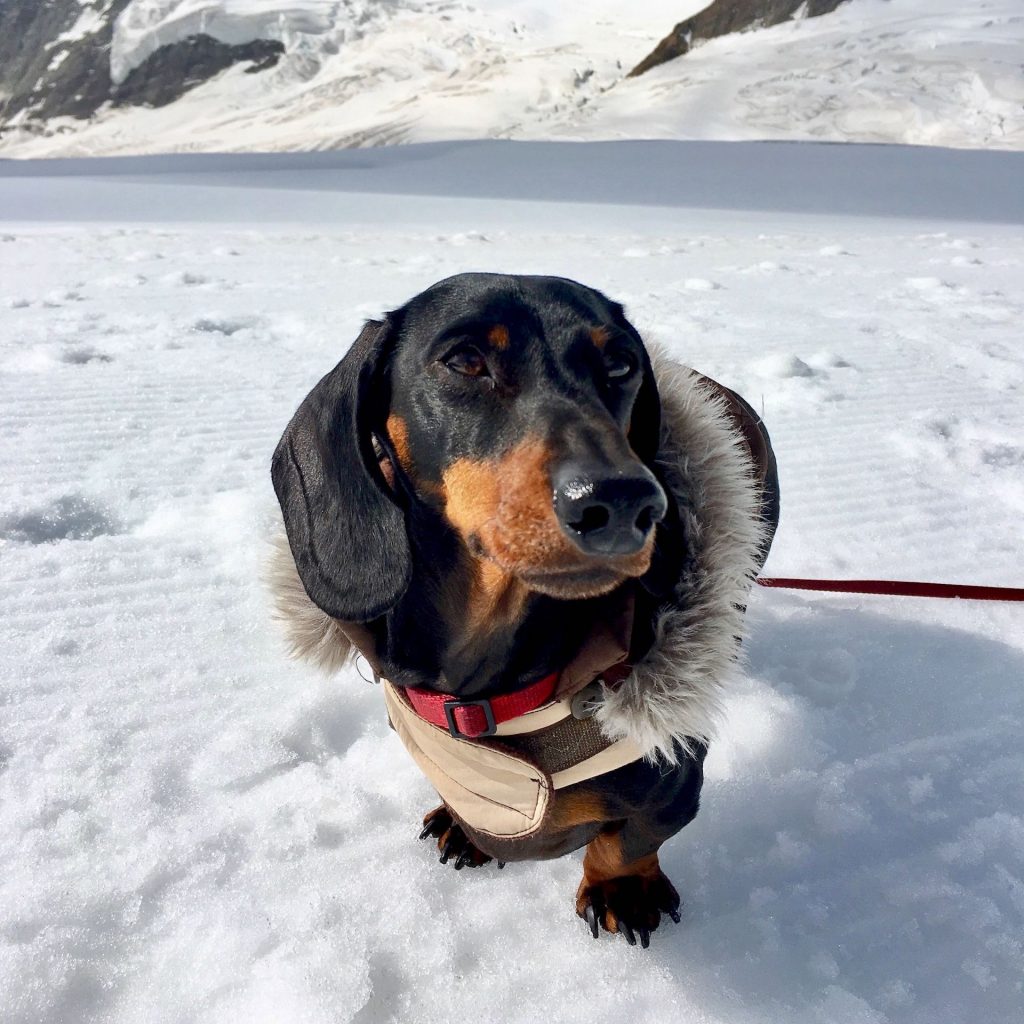
Looking for a dog-friendly hotel near Jungfraujoch? Check out the best hotels in Interlaken for all budgets, most of which are dog-friendly.
How to Get to Jungfraujoch by Train
Thanks to the rack railway constructed to Jungfraujoch, the main way to get to Jungfraujoch (short of hiking through the mountains) is by train. There are two components to the train to go up Jungfraujoch.
Firstly, there’s the regular railway from Interlaken Ost to Kleine Scheidegg, via either Lauterbrunnen or Grindelwald. You’ll need to change trains at either Lauterbrunnen or Grindelwald. Plus, it’s possible to start your journey from one of the intervening stations.
We started our day trip to Jungfraujoch in 2018 from Grindelwald Grund, near where we were staying, where there was also a convenient large carpark.
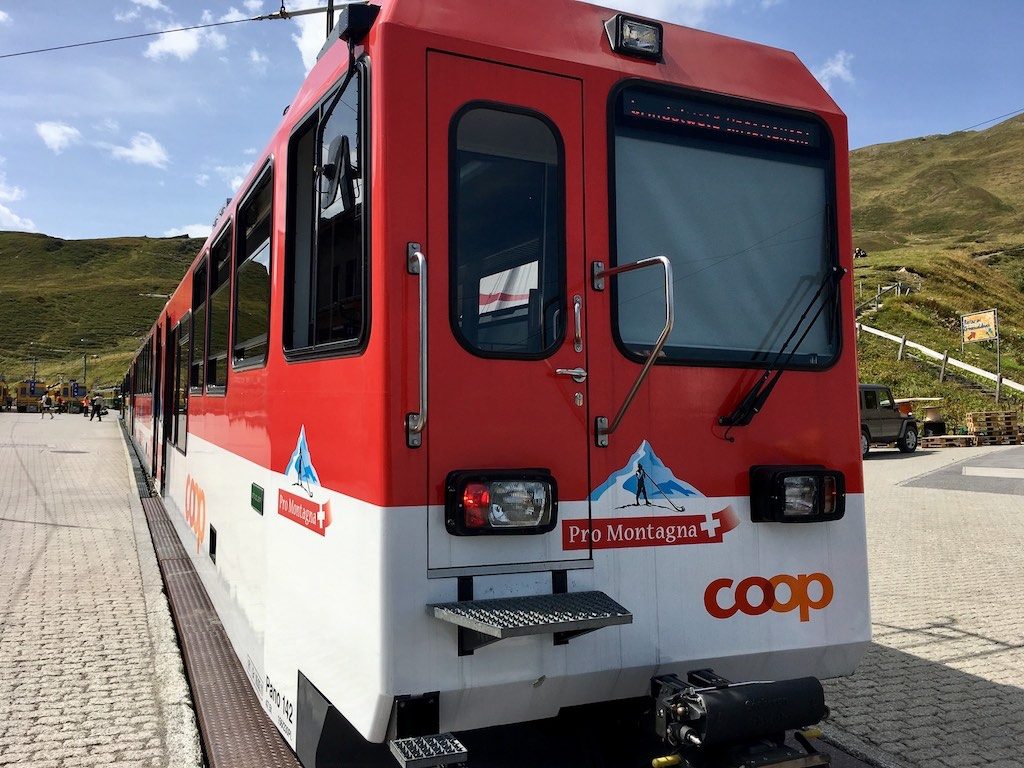
Secondly, there’s the actual Jungfrau Railway (or Jungfraubahn) in between Kleine Scheidegg and Jungfraujoch. This is the rack railway that is tunnelled through the mountains – an impressive feat and part of the attraction of a visit here!
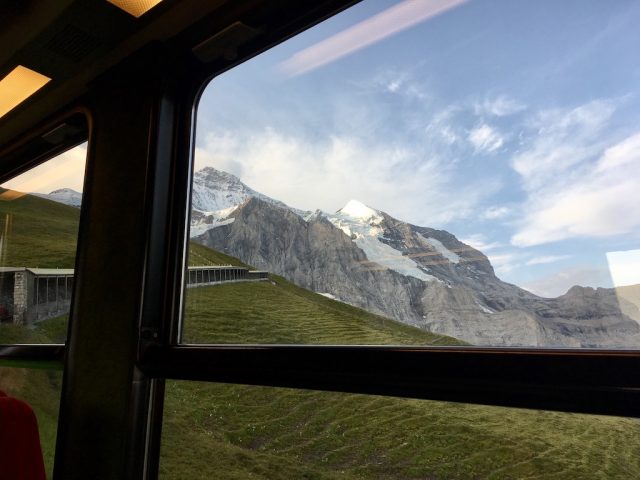
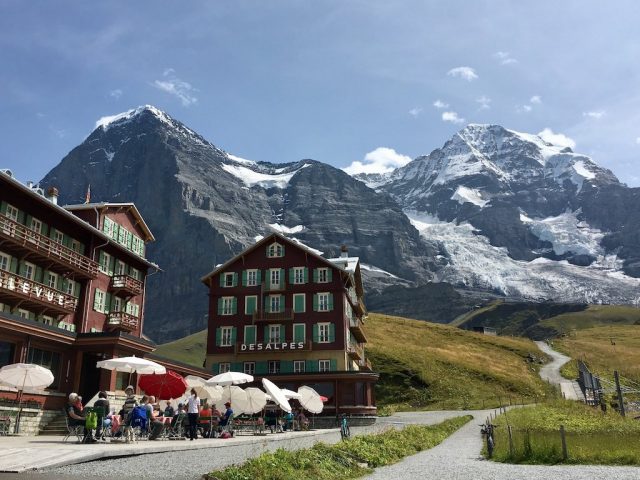
Since our visit, in December 2020 a new option opened. It is now possible to take the Eiger Express gondola in between Grindelwald Terminal, just before the main Grindelwald station, and Eigergletscher, part way along the Jungfrau Railway. The journey is far quicker, shaving 45 minutes off the journey time. There’s also a large new carpark at Grindelwald Terminal.
Cost to Take the Train to Jungfraujoch
Unfortunately, it’s very expensive to take the train up Jungfraujoch, especially if you don’t have a Swiss Rail Pass or similar. The standard price in 2022 to travel from Grindelwald up to Jungfraujoch and back during the peak summer season is 220 CHF per adult.
The cost is the same whether or not you take the Eiger Express gondola (you can book to take it both directions, one direction or not at all). Plus the cost varies slightly depending on where you start and end the journey. You can book tickets online.
On fine days during the peak season, it’s recommended that you reserve a seat on the Jungfrau Railway section. This means that you have priority of boarding the train. This costs an extra 5 CHF per person per trip (or 10 CHF return).
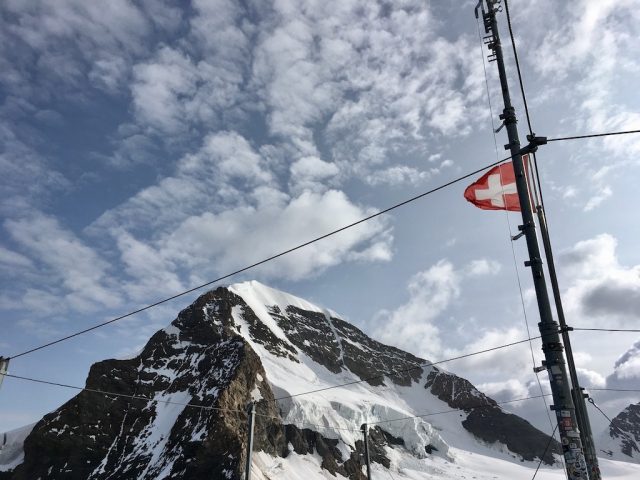
Previously, you could save around 60 CHF per adult by purchasing the Good Morning Ticket, which we did. In return you were restricted to the first two trains departing Kleine Scheidegg, at 8:00am or 8:30am.
However, I cannot see this offer online any longer and in fact, I don’t believe these early trains still operate.
Taking Your Dog Up Jungfraujoch
Dogs are allowed on all parts of the Jungfrau Railway network, including the regular trains to Kleine Scheidegg, the Jungfrau Railway up to Jungfraujoch and the Eiger Express gondola.
On the majority of the network dogs travel for free, including the regular railway from Interlaken Ost to Kleine Scheidegg, via either Lauterbrunnen or Grindelwald. For a full list of the free routes, click here. I believe dogs also travel for free on the Eiger Express gondola, like many cable cars in Switzerland.
However, a charge applies to all dogs travelling on the Jungfrau Railway. The cost is 30 CHF between Eigergletscher and Jungfraujoch, for the return journey. This is the common part of the route whether you take the Eiger Express gondola or the rack railway from Kleine Scheidegg.
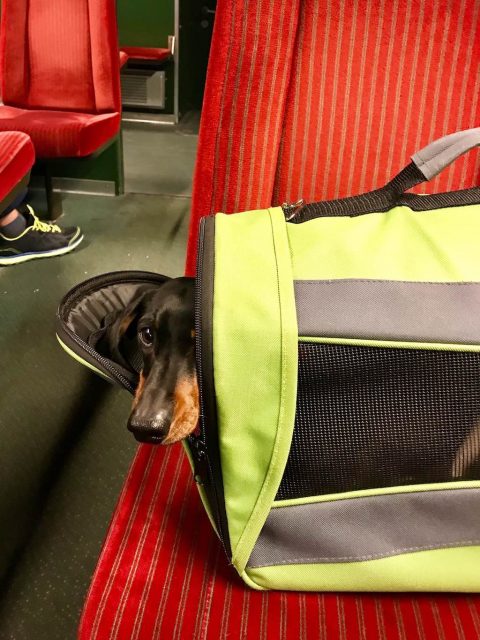
Previously, when I visited in 2018, small dogs up to 30cm shoulder height, that travelled in a crate or other suitable container, travelled for free. However, this no longer the case – all dogs require a ticket.
While not cheap, it’s still far cheaper than a half-price human ticket, like applies on many trains throughout Europe. Note that the dog tickets are only available at the train stations, so allow time to pick up a ticket for your pup.
What to do at Jungfraujoch
Part of the experience of visiting Jungfraujoch is the train and gondola ride itself. The sections of the railway (and these days the gondola) heading up to Kleine Scheidegg are very scenic.
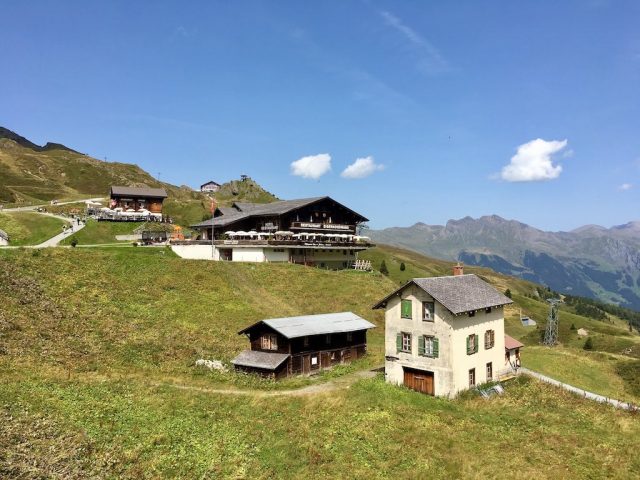
And while much of the Jungfrau Railway journey is in a tunnel, there is a stop along the way at the Eismeer station to view a glacier, plus it is amazing to realise the tunnel and railway was constructed over 100 years ago, cutting through these huge mountains.
At the top, I recommend firstly heading to the Sphinx Observatory viewing platform. There’s an elevator to take you up, to an even more impressive 3571m above sea level. You’ll have some of the most impressive views of the Aletsch Glacier and the surrounding peaks of Jungfrau and Mönch. And if it’s chilly, it’s easy to head back inside behind the glass walls.
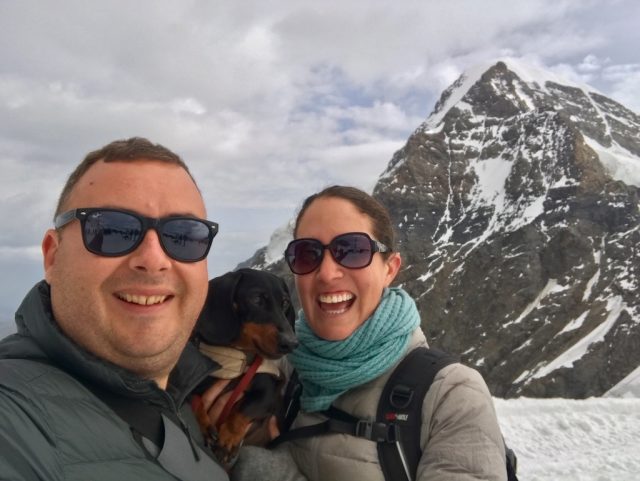
The best time to visit the observatory is first thing in the morning, particularly if you catch the first train, before it gets crowded. Perfect for mountain selfies!
Next up I recommend the Ice Palace (free for all visitors). Walk carefully through the tunnels constructed in ice, with ice sculptures and great photo opportunities along the way. It’s least slippery first thing in the morning, though there are handrails to hold onto the whole way and make sure you don’t slip.
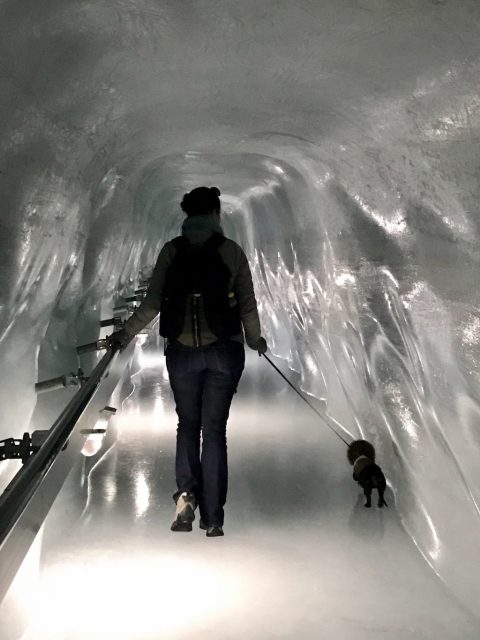
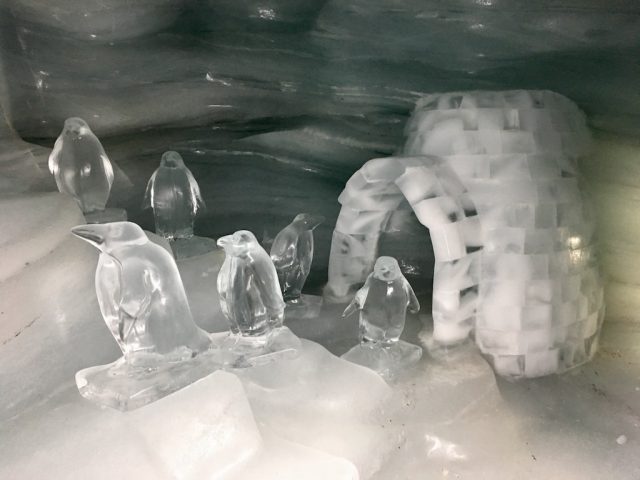
Dogs are welcome to join you in this part of Jungfraujoch. We weren’t sure how our dog would handle the ice, but I think his claws actually made it easier for him.
Just after the Ice Palace is a small area where you can head out onto the snow. However, there’s a far larger area accessible near the Sphinx Observatory elevator, at the Snow Fun Park. Here you’ll have the opportunity to ski, snowboard, ride on a sledge or snow tube, or ride a zipline.
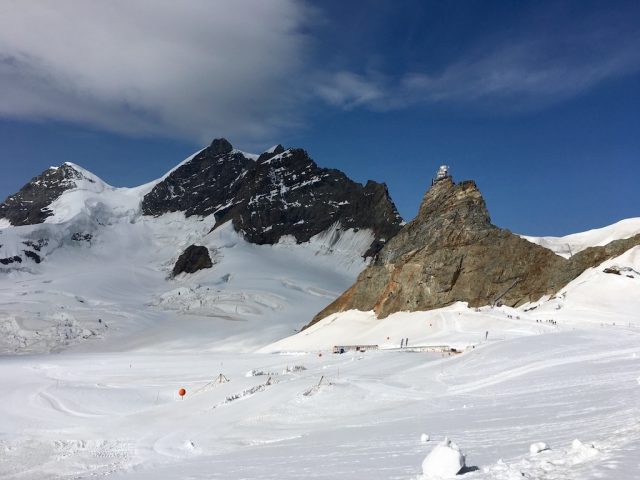
All activities cost extra, with the option of purchasing an all-day pass or paying for individual rides. The park is only open part of the year and subject to closures due to the weather – double check if it’ll be open, if you’re interested in enjoying the rides.
However, we didn’t even consider visiting the fun park (as it wasn’t an option with our dog) and instead hiked to Mönchsjochhütte.
Hiking to Mönchsjochhütte
The highlight of our visit to Jungfraujoch, other than the amazing views from everywhere of the surrounding mountains, was hiking to Mönchsjochhütte. It’s the highest altitude serviced hut in Switzerland, at 3650m altitude (so, yes, you’ll be hiking up hill).
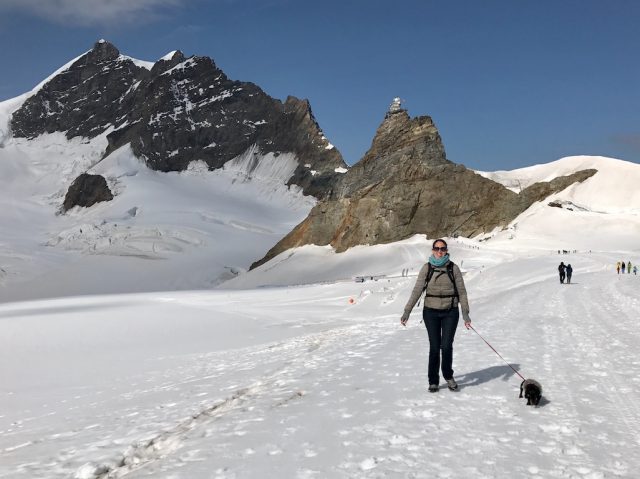
The hike is listed at taking about 45 minutes, but I recommend allowing an hour each way if you’re not used to walking in the snow. There’s a couple of handy markers along the way letting you know how much further it is to the beer at the hut!
If hiking this trail, it’s best to head up Jungfraujoch early in the morning and hike this trail first thing. When we hiked the trail around 9:30am, it was still fresh and firm. This in particular made it easy for our dog, Schnitzel, who at only 5kg, barely left a dent in the snow. We were worried about how he would manage, but it seemed easier for him than us pair of snow-newbies.
However, by the time we returned, the snow was already softening in the sun, and would have been tough if we were heading up hill.
Along the way and once you get to the hut, there’s some more beautiful views of the surrounding mountains. It’s a lot quieter and more serene than at Jungfraujoch itself.
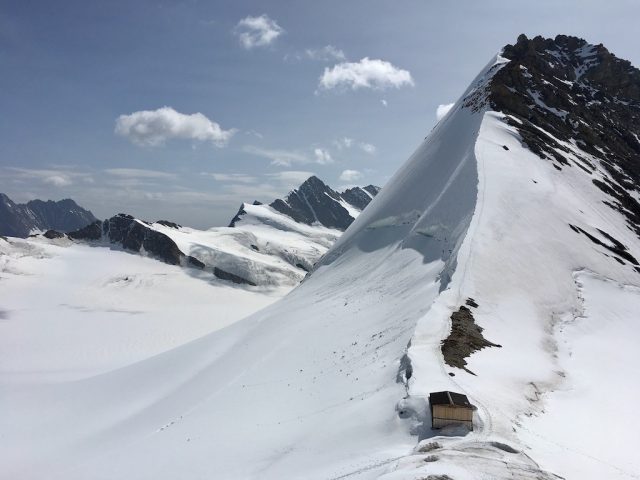
Fortunately, there were no restrictions on dogs entering the dining room at the time of our visit. While it was might be a bit early for lunch if you visit first thing in the morning, it’s a great spot for a scenic coffee or beer, plus to warm up in the cosy interior. Schnitzel was happy to snuggle up inside his carrier bag with his blanket!
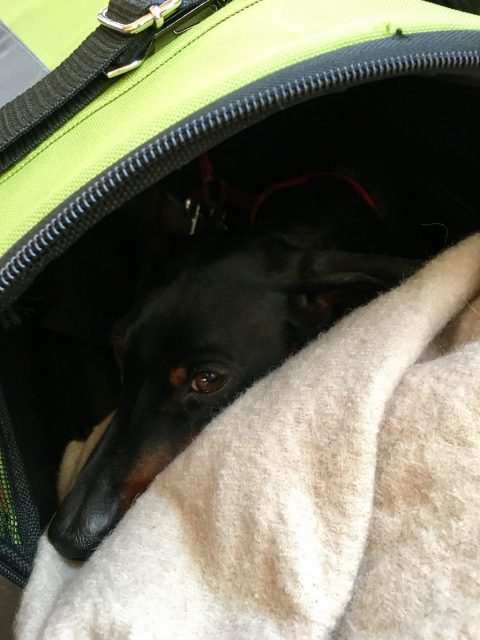
Food and Beverages at Jungfraujoch
Just like everywhere in Switzerland, dining out is not cheap at Jungfraujoch. As we were leaving early and missing the normal breakfast hours at our B&B, our host kindly packed us breakfast, which ended up being large enough for lunch, too. Alternatively, I would recommend packing your own food, courtesy of the Coop supermarkets the day before.
There’s multiple restaurant options at Jungfraujoch, including the Crystal restaurant, a self-service restaurant, and a simple cafe. However, I do believe dogs are not allowed in most of these venues. In contrast, dogs were fine in the dining room at Mönchsjochhütte.
Should You Take Your Dog Up Jungfraujoch?
There are two main reservations that some people have about taking a dog up Jungfraujoch: the altitude and the cold.
The altitude of Jungfraujoch is 3466m above sea level. In particular, it’s a large climb up from Grindelwald, down in the valley, which lies only at 1034m. This means that it’s possible to suffer from altitude sickness.
For humans, this means taking it easy and trying to not over-exert yourself, particularly if you notice that you’re easily out of breath. This varies between everyone, with many people not affected, but some affected.
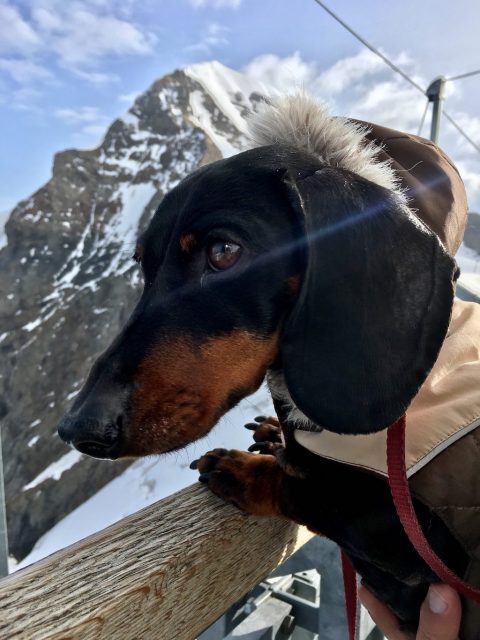
With your dog, they can’t tell you if they’re affected, in which case you should keep a close eye on them. If they seem reluctant to be active, take it easy with them and consider returning sooner rather than later down the mountain.
When it comes to cold, some dogs from places that experience a cold winter will already be used to cold temperatures and snow on the ground. But if you come from a warm place (for instance, Sydney in Australia, like I do), snow and such cold weather could be quite a surprise for your dog.
Most dogs should be fine to cope (for instance, in cold places most dogs still don’t wear jackets), but do take a jacket or jumper and bootees for your dog if you are concerned. If they’re small, picking them up and cuddling them into you can help them warm up quickly.
Our dog Schnitzel seemed to not be affected by the altitude. And while when we first headed outside he seemed unhappy with the cold (although that could have also been the wind), when we later went for a hike he seemed fine.
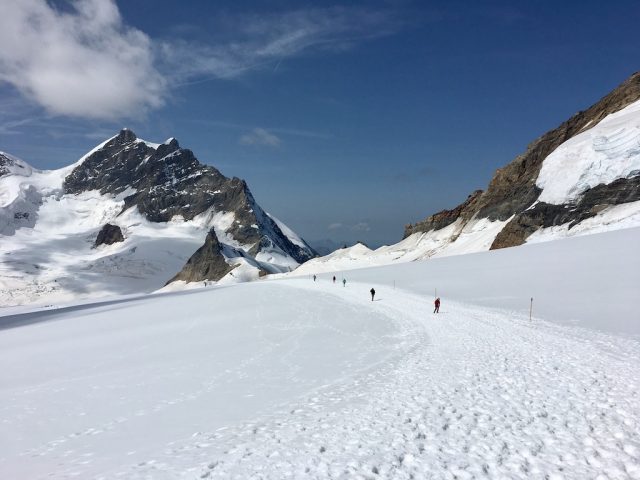
I was mainly concerned with his feet getting cold (he had on a jacket), so I occasionally picked him up and warmed up his feet. We also took along a towel for him in case we needed to dry him off or wrap him up. Plus as we had carried him in his carrier bag, he had his blanket inside of that.
My Verdict?
Visiting Jungfraujoch was a great experience, and we loved being able to share it with our dog, Schnitzel, especially the hike to Mönchsjochhütte. It’s a fun adventure in Europe, in particular if you haven’t often visited ski fields and experienced snow before.
Just one extra tip: it’s best to leave buying tickets to the day before. Wait and see what the weather forecast is like, as it’s not worthwhile spending so much money if it’s going to be cloudy with low visibility. Luckily the forecast was good for us, and the day was beautifully sunny and clear.
You May Also Like
About the Author

Shandos Cleaver is the founder of Travelnuity: Dog-Friendly Travel. She has travelled extensively with her Miniature Dachshund, Schnitzel, including to 33 countries across Europe, every state and territory of Australia except Tasmania, and 10 of the United States. She’s passionate about providing inspiration and information to others wanting to travel with their dogs, whether close to home or internationally.
Inspired? Pin this to your Pinterest board!
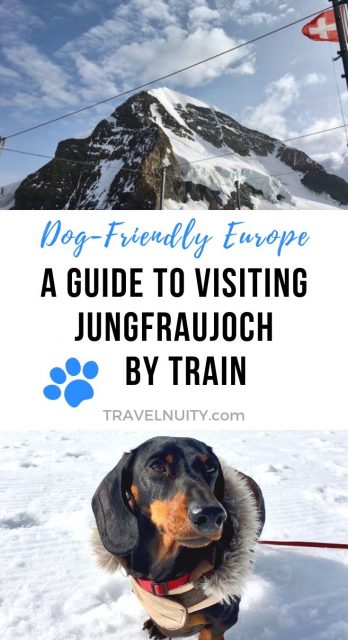

good article thanks
weekdog.com
Thanks for this detailed report. We plan to do the same with our Pharaoh Hound bitch Inca in July 2018, so your information has been very helpful. She is much bigger than Scnitzel, so she’ll need her own ticket.
That’s great to hear, have a wonderful time!
Hi Shandos, just come across your post. Really helpful. We are camping in Jungfrau in June for 5 days whilst on a Europe Road trip in our campervan. We are taking our Airdale, Baxter, with us. He loves the cold! If we don’t manage to get the early morning ticket, what are the other times that the train goes?
Glad it’s helpful and have a great time in a beautiful part of the world! I’m pretty sure the trains run every 30 minutes, definitely very regularly.
Thank you for sharing your experience. I’d like to know if your dog has been to anywhere as high elevation as Jungfrau before and if there’s any precaution to take? I was told that most dogs can get sick when they get past 8000 feet and Jungfrau is like over 11000 feet in elevation… I’m worried if my dog can handle it.
Tory – It was Schnitzel’s first experience at altitude. I expect that dogs handle altitude similarly to humans, with different people affected at different altitudes or different experiences at different times.
Schnitzel showed no signs of being affected, but I kept a close eye on him for any symptoms, such as seeming off-colour, not eager to walk/play, etc. If that does happen, I recommend restricting your dog’s movement and descending as soon as possible.
Hi just come across your great review.
We are going in May with our 2 English Staffordshire Bull Terriers. Not too sure whether to take them up but after reading your review if the weather is good then we might as well.
Steve
Wishing you all the best with the weather and a great adventure!
Many thanks for a very interesting and helpful article. We shall be there in August with our dog and I look forward to doing the same trip as you. I particularly look forward to hiking to the Mönchsjochhütte which I wasn’t previously aware of!
Great to hear Jonathan, have a wonderful visit!
Many thanks for this article. Are there any lockers where we can store the dog carrier while exploring ?
Yes, there are indeed lockers, see the map on this brochure. https://www.jungfrau.ch/fileadmin/Prospekte_und_Broschueren/Jungfraujoch_Prospekt.pdf
I have a cavalier King Charles spaniel weighs 9kg. Do they have to be in a carrier on the train
For dogs to travel for free on the Jungfrau Railway, they need to be in a carrier. However, dogs don’t need to be in a carrier on either train, simply on the Jungfrau Railway they’ll be charged a fee.
We also took our dog’s carrier so we could keep him warm inside with blankets.
Hi, can you share tips with us on how you travel from UK to Switzerland?
Sorry, but I haven’t travelled directly between the two countries. I’d recommend taking the Stenaline ferry to Hook of Holland, and then the train. Or ask for advice in my Facebook group: https://www.facebook.com/groups/dogfriendlytravelrtw/
Bonjour,
Merci pour les infos !
Vous avez habité en Australie avec votre chien ? Comment ça se passe la vie là-bas pour eux ? OZ est dogfriendly ? Y a-t-il des animaux dangereux pour eux : serpents, mygales… ? Y en a-t-il partout svp ? Même questions pour la Nouvelle Zélande svp ? Je voudrais y vivre (ainsi qu’en NZ) avec ma chienne.
Merci pour ce blog et bon voyages avec votre Schnitzel 🙂
Pukka
Merci! I have lived in Australia with my dog – it is my home country and we are back again living in Australia after spending a few years in Europe. Australia is not as dog-friendly as Europe, but there are lots of great dog-friendly beaches. There are dangerous animals, but the main dangerous animal around Sydney are ticks, so I give my dog a tick tablet. NZ is similar to Australia in terms of dog-friendliness, but without as many dangers. Note that quarantine is required for both countries. Hope this helps!
Hello! I’m considering visiting Europe with my dog (from Canada). Would your comments about potential altitude issue apply to Kleine Schedigg as the home base itself or going from there up to jungfraujoch?
Also, did you find any dog walkers in Kleine Schedigg? Thinking about the possibility to leave him for a day while skiing.
And any tips for Alta Badia as well?
Thanks!
Kerri – The comments about altitude mainly apply at Jungfraujoch, which is 3463m above sea level. Kleine Schedigg is only 2061m above sea level – still high, but not usually an altitude that affects humans, and presumably dogs. We had no issues though even at Jungfraujoch with our dog.
Sorry, but I can’t help you out with suggestions for dog walkers. I recommend asking your accommodation. We loved visiting the Dolomites, but it was in the middle of summer, a very different experience. Just like in Switzerland, dogs are usually allowed in the cable cars – we took the one up Marmolada wityh Schnitzel.